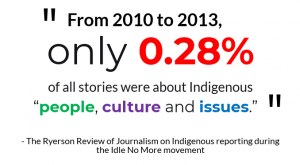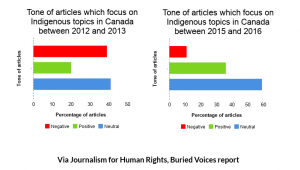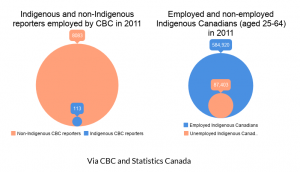Lenny Carpenter talks about how media coverage on Indigenous community changes over the years
RSJ/Manuela Vega
Journalists for Human Rights (JHR) partnered with Seneca College to offer a new scholarship for Indigenous students pursuing journalism at York campus Thursday, Nov. 15.
The scholarship covers tuition fees for students studying media programs at Seneca who identify as First Nations, Métis or Inuit.
The scholarship is part of JHR’s Indigenous Reporters Program, which aims to increase the quality and quantity of Indigenous stories and voices in Canadian media, according to Lenny Carpenter, the manager of the program.
Carpenter, who is also a member of Attawapiskat FN, said that Indigenous voices in mainstream media had greatly improved over the years.
“[Ontario newsrooms] weren’t covering [Indigenous communities] as much as they should be,” said Carpenter. “Ontario media was covering seven times less of what should have been proportionally covered [from 2010 to 2013].”

From 2015 to 2016, about 7,500 Indigenous stories were identified out of a total 1,449,422, according to JHR’s study. Carpenter said that it was an increase, “but it is still four time less.”
Ryerson visiting professor Duncan McCue said, he did see “key changes in the attitude in journalism schools and mainstream media.”
When he was a professor at University of British Columbia a decade ago, Indigenous cultures and history were considered “challenging topics for students to engage in.”
“What we are seeing is a shift in tone over the past three years,” said McCue on JHR’s study. “There’s been a steady drop in ‘negative’ news coverage since the first data collection.”

The negative tone in Indigenous news stories shifted from 39 per cent in 2013 to 11 per cent in 2016. Carpenter believes that the social movements at the time have given Canadian media the sense “to cover this issue more respectfully and accurately.”
Paul Robitaille, a youth representative of the Métis First Nations, believes that the news coverage in recent years is getting better. “I think that especially over the past few years, there have been a real push to create space for marginalized communities such as the Indigenous community to tell their stories,” said Robitaille.
Lenny Carpenter oversees the Indigenous reporter program at JHR. The program supports Indigenous journalists and journalism students, as well as educates non-Indigenous students on history fundamentals and stereotypes to avoid.
McCue “applauded greatly” for what JHR had done for journalism schools and newsrooms in Ontario and Manitoba, but he had one critique for the program.
“One worry is that the courses tend to be a history lesson in a short period of time,” said McCue. “It is difficult to learn the complicated political history of First Nations if you haven’t been taught before.”
McCue also suggested encouraging non-Indigenous students to change the way they approach Indigenous subjects. “The road-map to getting towards that goal [that journalists need to do better in writing about Indigenous communities] means training.”
Application for the scholarship is now being accepted for first year students at Seneca. The deadline to apply is Tuesday, Dec. 4, 2018.


Leave a Reply